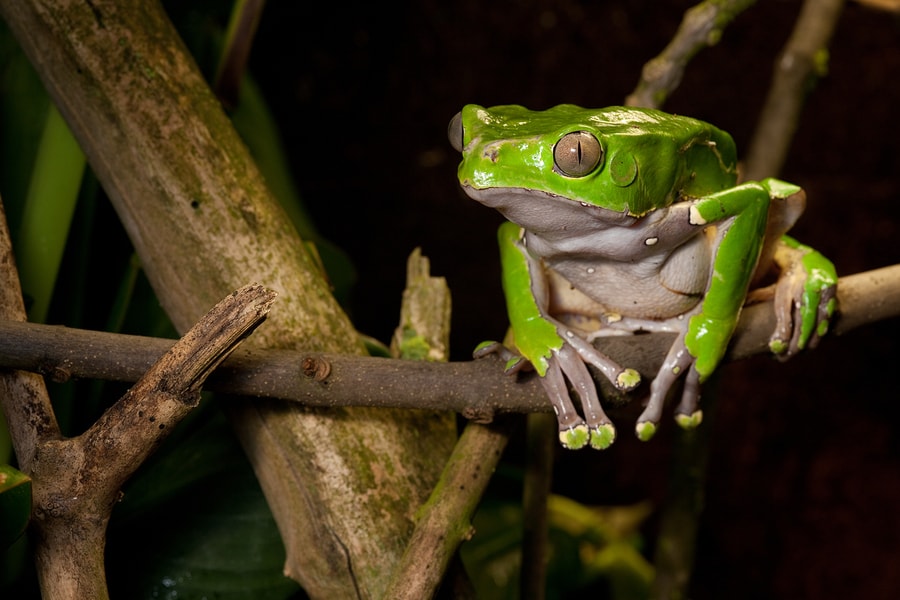
The poisonous secretion of the Amazon tree frog has many names. The most popular is Kambo, but it is also known as “sapo,” the “toad vaccine,” or “medicine of the forest.” It is traditionally used in ceremonies, as it allegedly helps with ailments of the mind, body, and spirit. It is also said to have powerful cleansing effects. Is Kambo safe and how much do we know about it? Read on to learn about the effects and dangers of Kambo.
What is Kambo?
Overview
Kambo is harvested from the poisonous secretions of the Amazon tree frog, Phyllomedusa bicolor. Kambo is traditionally used to remove “Panema,” or negative energy, which is said to result in numerous health benefits such as gaining strength and maintaining health. It is also historically used to aid with mental illness and addiction [1].
The Kambo ceremony involves making several small burns at specific locations on the body and applying the poison to the burns. Kambo initially causes a generally unpleasant period of increased heart rate, nausea, vomiting, and incontinence that lasts 30 to 40 minutes. This is followed by a period of listlessness and eventually some long-lasting effects [2].
The use of Kambo in the traditional ceremony has not been studied in any randomized controlled trials. Clinical research needs to determine the safety and effects of kambo on the human body.
There is no evidence to suggest that kambo (or “body cleanses” for that matter) has any health benefits. On the contrary, Kambo is likely dangerous.
Have in mind that kambo is a poison that can cause serious side effects. Several deaths have been reported. Additionally, it is applied after making open burns and wounds on the skin, which is a dangerous process by itself. Burning or cutting the skin and deeper skin layers can result in infection, excessive bleeding, severe swelling, and even death.
Despite the lack of evidence and serious potential for harm, “Kambo sticks” are commercially available on the internet and Kambo is legal in the US and many other countries [1].
These kambo “sticks” are unregulated, may have unpredictable strengths, and should be avoided.
We strictly advise against the use of kambo until its safety profile and dangers have been determined.
Some studies have investigated the health effects of active peptides found in the frog venom. These studies help scientists explore biological mechanisms and understand whether any of these compounds have medicinal potential. However, these findings can’t be extrapolated to humans [3].
Components
Kambo contains many peptides that are suspected to be biologically active, including phyllocaerulein, phyllomedusin, phyllokinin, sauvagine, dermaseptins, adenoregulin, deltorphin, and dermorphin [3, 1, 4].
Their proposed mechanism of action is explained in the following section.
Potential Mechanism of Action
Scientists suspect that the peptides from Kambo may have diverse effects. Limited evidence suggests that they are absorbed directly into the bloodstream through burns in the skin. Researchers are investigating whether peptides in Kambo can have the following effects in animals and cells:
- Phyllocaerulein (150 to 600 ug/g fresh tissue) – may stimulate gut flow, stomach acid secretion, and low blood pressure [5].
- Phyllomedusin (tachykinin, NK1 activator) and phyllokinin (bradykinin) – may contract the gut and dilate blood vessels. Phyllomedusin may also act on the brain to alter consciousness and behavior [6, 7, 8, 9].
- Sauvagine – may stimulate the adrenals and dopamine release. It seems to cause the smooth muscles to contract and might act as a depressant in the brain (i.e., “downer”) [10, 2].
- Dermaseptin B2 – may be active against some microbes in dishes [4].
- Adenoregulin – may affect the activity of neurotransmitters and compounds (adenosine, adrenaline, and serotonin (5-HT1A)). Scientists think it’s responsible for the initial listlessness and eventually an intense “flight-or-fight” response [11, 12].
- Deltorphins (delta-opioid receptor activator) and dermorphin (mu-opioid receptor activator) – may act as opioids to potentially relieve pain and induce euphoria [13, 14].
These mechanisms have not been confirmed in clinical trials.
Natural Sources
Traditionally, Kambo is the poisonous secretion found on the limbs of the tree frog, Phyllomedusa Bicolor. However, several other species in the Phyllomedusa family produce poisons containing similar peptides [15].
Kambo Ceremony
Kambo is generally harvested from the tree frog early in the morning when a tribal person follows the song of the frog. Once caught, the frog is tied in an “x” shape and the poisonous secretions are carefully scraped from their legs and stored on wooden sticks for use in the Kambo ceremony. The frog is released back to the wild unharmed [1].
The ritual begins by burning several small holes into the skin (generally on the arms for men and legs for women). Dried Kambo is then reconstituted with either spit or water and applied to the fresh wounds [1].
Kambo causes immediate and generally unpleasant gastrointestinal and cardiovascular effects, such as purging, incontinence, and rapid heart rate.
Ultimately, users report experiencing some beneficial effects, such as increased strength, heightened senses, lack of hunger or thirst, and increased ability to face stressful situations. These have not been properly studied and may well be a placebo effect [1, 16].
Traditionally, Kambo ceremonies are utilized prior to a hunting expedition in many South American countries such as Bolivia, Brazil, Colombia, Peru, French Guiana, Suriname, and Venezuela [1, 16].
Purported Effects of Kambo
Lacking Evidence for:
No clinical evidence supports the use of Kambo for any of the conditions listed in this section.
Below is a summary of the existing animal and cell-based research, which should guide further investigational efforts. However, the studies listed below should not be interpreted as supportive of any health benefit.
1) The Kambo Cleanse
Kambo is known for its intense and immediate purgatory effects that generally result in vomiting and diarrhea that can last up to 4 hours. Traditionally healers claim this “removes toxins from the body” [17, 1, 12, 16].
The ritual, performed by both tribes and urban people, has been documented and described in detail. Some scientists suspect that several peptides in Kambo may be responsible for the effect, but this is still unknown [17, 1, 12, 16].
For example, the phylloceruelean peptide in Kambo increased acid production in the stomach, contracted the small intestine, and increased pancreas activity in dogs. This peptide had similar effects in rats, as did phyllomedusin. However, neither of these compounds have been studied in humans [5, 7].
2) Stress and Anxiety
Kambo users frequently report improved mood. Proper clinical trials are lacking to support such anecdotes.
The Kambo peptide, dermorphin, decreased blood levels of the “stress hormone” cortisol in a small study of 28 healthy human subjects. It also increased prolactin, the “milk hormone.” This study is highly unreliable – it was published in the ’80s and its findings have never been replicated. Possibly, future studies showed a lack of effect or safety issues [18].
In another study published in 1991, rats given deltorphins experienced an increase in overall movement and social interactions, which points to a decrease in anxiety [19].
In the meantime, a synthetic dermorphin called Opilong has been synthesized. This compound reduced pain and anxiety in rats under stress after several days of repeated use. Further human studies are needed. However, remember that Opilong is only similar to compounds in Kambo, but it’s synthetic and purified. Kambo does not contain it [20].
3) Pain Relief
Deltorphin and dermorphin, found in the skin of the Amazon frog (Phyllomedusa bicolor and other related species), are opioid peptides. Some scientists are investigating their potential pain-relieving effects. However, their effectiveness and toxicity remain unclear [15].
Researchers are investigating the following pain pathways with deltorphin peptides in animals or tissues:
- Opioid activity (via delta-opioid receptors) [21].
- Anti-inflammatory properties [22].
- Blood-brain barrier passage [23].
Many research efforts are directed toward discovering peptides similar to deltorphin for the treatment of pain. Since dermorphin might also affect opioid pathways (but via mu-opioid receptors), researchers are aiming to optimize dermorphin as an alternative to some opioid painkiller. However, none of these new compounds have yet passed clinical trials [21, 24, 25, 26, 27, 28, 29, 14, 30, 31, 32].
4) Addiction
Tachykinins are small proteins that have been implicated in reward, motivation, and stress responses in the brain, which are hypothesized to be disrupted in addiction. Some scientists think that molecules that can reach the brain and increase tachykinin activity (by binding to receptors) have the potential for treating addiction [33].
Phyllomedusin is one tachykinin found in Kambo. Researchers are investigating whether it has any effects on addiction, but human studies are still lacking [34, 1].
5) Blood Pressure and Blood Flow
Kambo users commonly report a drop in blood pressure as one of their symptoms during the initial unpleasant phase of Kambo cleansing.
However, the effects of Kambo peptides on blood pressure and blood flow in humans are unknown.
Two peptides found in Kambo (phylloceruelean and a physalaemin-like peptide) lowered blood pressure in dogs [17, 5].
Mice given deltorphin II, one of the peptides from Kambo, had increased blood flow to the heart, which prevented irregular heartbeat when given to mice prior to having a heart attack. This peptide is being further researched for its effects on heart attack complications in animals [35, 36].
6) Infection
Scientists are investigating whether any of the peptides found in the secretions of the tree frog can fight microbes. They suspect these peptides protect the frog from infections, potentially with a wide spectrum of microbe-fighting activity in this animal, but their effects in humans are completely unexplored [37, 38].
What’s more, the burns and cuts created during a Kambo ceremony increase the risk of infection.
Research teams have looked at the effects of the following active compounds on the following microbes in dishes:
- Adenoregulin against fungi and bacteria, including E. coli [39, 40, 41, 42].
- Dermaseptins against viruses, gram-positive and gram-negative bacteria as well as yeast [43, 37, 44, 45].
- Dermaseptins on biofilm growth (biofilms are thought to be notoriously resistant and difficult to treat, often requiring high doses of antibiotics) [46].
- Phyllospetin-1 against bacteria that commonly cause skin infections (Staphylococcus aureus) and their associated biofilms [47].
Cancer Research
Kambo does not prevent or treat cancer.
Scientists are investigating the effects of the following Kambo compounds:
- Dermaseptin B2 on prostate cancer in animals and on other types of cancer cells in dishes [48, 49, 4, 43].
- Dermaseptin nanoparticles in cancer cells [50].
Many substances have anti-cancer effects in cells, including downright toxic chemicals like bleach. This doesn’t mean that they have any medical value. On the contrary, most substances (natural or synthetic) that are researched in cancer cells fail to pass further animal studies or clinical trials due to a lack of safety or efficacy.
Kambo Side Effects and Warnings
In addition to the unpleasant effects (increased heart rate, nausea, vomiting, incontinence) that occur upon application of Kambo, there are several reports of more serious side effects [51, 17].
In a forensic study, a 42-year-old man was found dead in his home next to a box of “Kambo sticks.” He had deltorphin A in his blood and enlarged heart tissue upon autopsy. They concluded that continued use of Kambo likely caused the sudden death [52].
A case report of a 44-year-old woman undergoing a Kambo ritual in Slovenia reported many undesirable effects, including nausea and vomiting, confusion, muscle weakness, cramps, seizures, decreased consciousness level, and short-term memory loss. Low ADH levels (confirmed with lab tests) and excess water consumption likely contributed to her symptoms. It took a full 3 days for her to recover with treatment [53].
In another case, a 34-year-old man had liver damage after weekly applications of Kambo that continued for 2 months [54].
In rats, the sauvagine peptide found in Kambo caused a drop in body temperature (hypothermia) [10].
Additionally, creating burns in your skin always comes with the risk of infection and a high likelihood of scarring [1].
Kambo may alter brain chemistry and has not been studied in RCTs. Although reports of shamans “healing people” struggling with mental health problems are numerous, these claims are highly limited and controversial. People with an unstable mental illness should avoid Kambo due to the dangers involved and a lack of safety data [55, 56, 57].
Drug Interactions
Currently, information is lacking about Kambo drug interactions. However, it is well documented that Kambo causes vomiting and diarrhea, which can alter the concentration of prescription drugs and electrolytes in the body, which is a reason for serious caution in people who take prescription or over-the-counter medications [53].
Limitations and Caveats
Several blogs state that kambo should be used only under direct supervision, ideally with someone who has experience with the traditional ceremony. However, we advise against any type of Kambo use or ceremony until the safety of this procedure is confirmed in proper clinical trials.
To date, there have been no clinical trials to prove the reported “cleansing effect“ of the Kambo ritual or any other health benefit of Kambo or its compounds.
User Experiences
The opinions expressed in this section are solely those of the users who may or may not have medical or scientific training. Their reviews do not represent the opinions of SelfHacked. SelfHacked does not endorse any specific product, service, or treatment.
Do not consider user experiences as medical advice. Never delay or disregard seeking professional medical advice from your doctor or another qualified healthcare provider because of something you have read on SelfHacked. We understand that reading individual, real-life experiences can be a helpful resource, but it is never a substitute for professional medical advice, diagnosis, or treatment from a qualified healthcare provider.
The most obvious and immediate effect of Kambo is purging or cleansing. Many people use Kambo to prepare their bodies for an ayahuasca ceremony. Users feel that Kambo “completely cleanses the body” so that they are able to enjoy ayahuasca without purging.
Many people seek a Kambo ceremony to remove negative energy from their life and emerge from it with a more positive energy and outlook.
Many users say felt a shared bond between others in their Kambo ceremony and appreciated feeling connected to those around them.
Some people using Kambo to combat substance find it somewhat easier to stay sober after a Kambo ceremony, but note that they begin slipping into old habits after some time and require Kambo ceremonies somewhat regularly.
Several users experiencing chronic fatigue have noted an increase in energy after the continual use of Kambo (weekly).
It’s also important to note that many Kambo users and practitioners warn against taking the frog poison by mouth as it can lead to what Shamans call the “Frog Disease,” which includes weak muscles, serious heart complications, and even death.
Genes that May Affect the Response to Kambo
OPRM1 is the gene that codes for the mu-opioid receptor, and at least 4 variants exist in humans. Since dermorphin targets these, differences in OPRM1 genes could hypothetically result in different responses to Kambo [58, 59].
OPRD1 is the gene that codes for the delta–opioid receptor, which is the proposed target of the Kambo peptide, deltorphin. One variant of OPRD1 increased pain sensitivity in a human study of 92 patients with arthritis in hips. Users with this particular variant of OPRD1 may theoretically be less sensitive to Kambo effects [59].
Genetic variation in the genes that influence serotonin (such as those affecting 5HT1A receptors), a target of Kambo (adenoregulin) may theoretically alter its effect in the brain [60].


